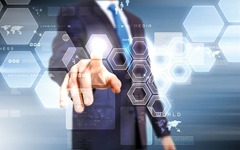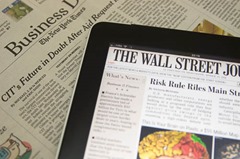Creating a data-driven society
 Professor Barry Smyth outlines the growing potential of the convergence between small sensors and big data. Technology can increasingly analyse a range of trends but it also reveals a lot about citizens’ private lives.
Professor Barry Smyth outlines the growing potential of the convergence between small sensors and big data. Technology can increasingly analyse a range of trends but it also reveals a lot about citizens’ private lives.
Data is everywhere. It is created as we live, work, and play, from our actions and interactions, online and offline. The ability to capture, understand, and act on this data has the potential to create a healthier, safer, and fairer society for us all to enjoy. This is the promise of the world of big data analytics but it is a promise that can only be made if we are all willing to recognise and confront some important challenges that go hand in hand with this unashamedly (some might say naively) optimistic view of the future.
How much data is out there anyway? We need to think in terms of exabytes. An exabyte is a rather large unit of information. One byte of information corresponds to a single letter. We are used to dealing in kilobytes (thousands of bytes) and megabytes (millions of bytes) and nowadays, even gigabytes (billions of bytes). But an exabyte is equal to a billion gigabytes. To put this into perspective, five exabytes would be sufficient to store all of the words ever spoken by humans. But today we are creating one new exabyte of data every five or six hours.
Where is all of this data coming from? A lot of this data is created through our online activities — the endless logs of our online activities stored by businesses large and small, or the hundreds of thousands of hours of new video that is uploaded to sites like YouTube every day — but it is also created as a direct result of our real-world activities. For example, modern smartphones are a veritable listening post for our daily habits. A smartphone comes loaded with sensors, from location, movement and direction information to light, temperature, video and audio, effectively turning a subscriber-base into an always-on, location-aware, mobile sensor network.
This, in turn, introduces a whole host of interesting and disruptive possibilities when it comes to the next generation of technology and business innovation, including the potential disruption of diverse areas such as retail, healthcare, transport, agri-food, and energy. For example, free apps are now available for smartphones that are capable of using the phone’s camera to estimate a user’s heart rate by detecting tiny colour changes in the user’s skin due to blood flow.
Health insights
 Elsewhere, researchers have demonstrated how a smartphone’s microphone can be used to conduct a basic lung function test by analysing the data produced as a user blows into the microphone. By using sophisticated machine learning and pattern recognition techniques, it is possible to translate basic sensor measurements, whether patterns of skin colour or the shape of an audio waveform, into meaningful diagnostic signals. And all of this from the sensors that come as standard on our smartphones, to say nothing of the blood glucose or portable EEG peripherals that can now be purchased to extend a smartphone’s usefulness into more specialised areas of physiological sensing.
Elsewhere, researchers have demonstrated how a smartphone’s microphone can be used to conduct a basic lung function test by analysing the data produced as a user blows into the microphone. By using sophisticated machine learning and pattern recognition techniques, it is possible to translate basic sensor measurements, whether patterns of skin colour or the shape of an audio waveform, into meaningful diagnostic signals. And all of this from the sensors that come as standard on our smartphones, to say nothing of the blood glucose or portable EEG peripherals that can now be purchased to extend a smartphone’s usefulness into more specialised areas of physiological sensing.
It is now commonplace for individuals to track their exercise, food intake, even their caffeine consumption, again using free mobile apps. Imagine the impact on healthcare as smartphone capabilities continue to evolve, providing users with access to a wide range of apps that can capture and analyse a host of clinical and lifestyle indicators and so create new opportunities for more efficient and personalised treatment.
As a recent episode of the BBC’s Horizon documentary series speculated, it won’t be long before we leave the clinic not with a prescription but with a new app that is capable of monitoring some important aspect of our physiology, while providing a real-time stream of data back to our healthcare professional.
The power of data-driven thinking often comes as new uses are imagined for data that was collected with a different purpose in mind. For example, Propeller Health is a company that focuses on producing sensors and mobile apps that aid in the management of chronic respiratory disease. They produce a small sensor that attaches to a standard rescue inhaler. It tracks when you use your inhaler and, because it can be connected to an app on your phone; it can also note where you use your inhaler.
On the one hand, this data is useful to a physician as a way to better understand a sufferer’s condition. But, because inhaler use correlates with air quality, as thousands or even millions of suffers use such devices, the data can be aggregated to build a real-time map of air quality, across a neighbourhood, city or region. This can provide governments and agencies with valuable information that would be hugely expensive to capture via more conventional means.
Here in Ireland, companies such as Treemetrics are applying data-driven thinking to the harvesting of valuable natural resources such as our forests. Their solution combines satellite data with individual 3D tree profiles so that forestry managers can more precisely match supply with demand to extract the maximum value from every tree.
Irish startup Storyful (now a subsidiary of News Corp) has disrupted the traditional newsroom with its own approach to data-driven thinking. Its news verification technology can distinguish between genuine and fake news by tracing the original information source and by using a combination of human and machine insights to determine authenticity. Today Storyful is helping to fact-check stories for newsrooms around the world to create a more authentic and truthful internet.
Drawbacks
Lest we think that our data-driven future can only be positive, society obviously needs to come to terms with the darker side of big data. Much of the data that drives this vision is personal in nature. On the internet, we pay for the many free services with the bits and bytes of our personalities, which we reveal as we search, browse, and shop online. In the world of the sensor web, this is extending to our real-world actions. Who owns this personal data? How can and should it be used, with and without our consent? These are just some of the very many questions that have been raised, but not answered, when it comes to privacy in an increasingly security-conscious world today.
We all know the names of the companies at the leading edge of the big data revolution. Corporations like Google, facebook, amazon, and twitter all have their origins in a data-driven vision of society, which has disrupted key markets such as retail, advertising and news. But soon every company will need to be a big data company if they are to maintain their edge in what will become an increasingly competitive, insight-driven marketplace.
Organisations across the world will take advantage of this data-driven potential, from the largest corporation to the smallest corner shop, but society must adapt to ensure that the needs of the many are not trampled on by the ambition of the few. By striking the right balance between how we create, share and use data, we can create a safer, healthier, and fairer society for us all to enjoy.
Barry Smyth is Digital Professor of Computer Science and CEO of the Insight Centre for Data Analytics at University College Dublin.





